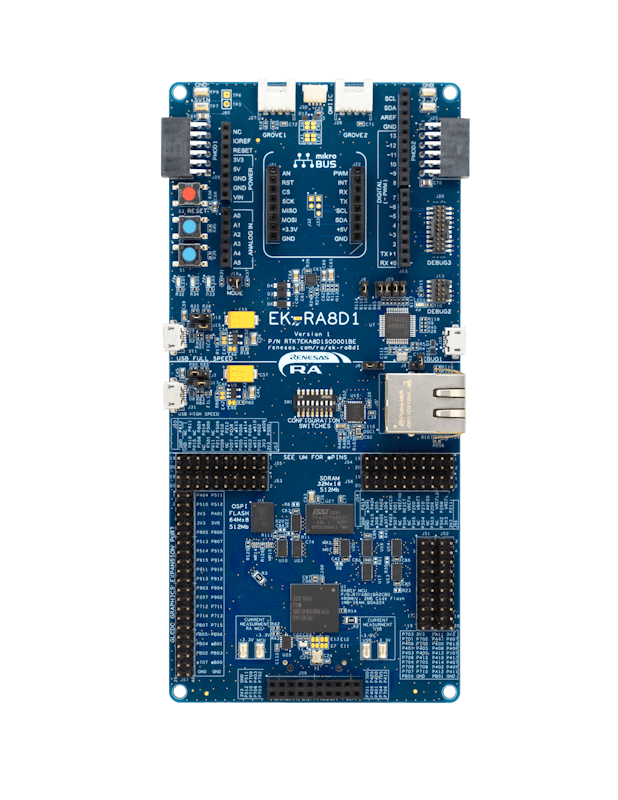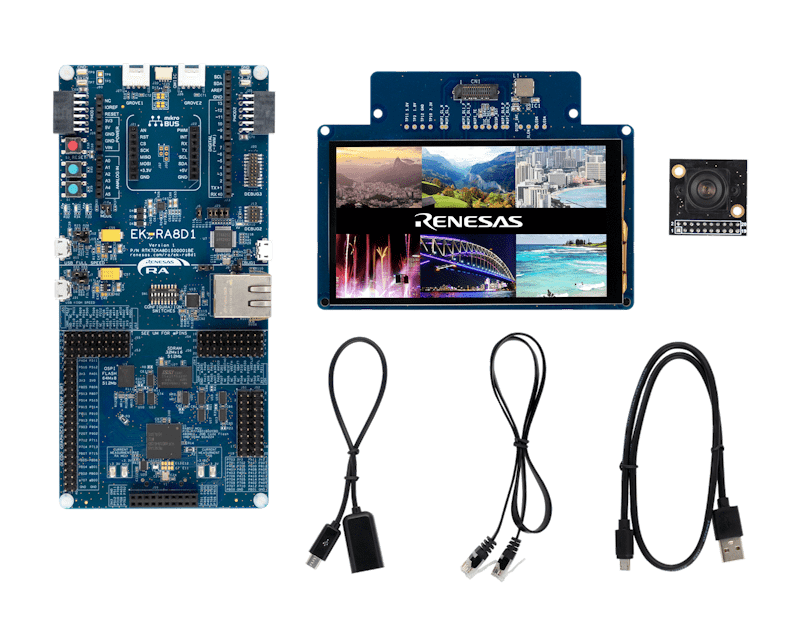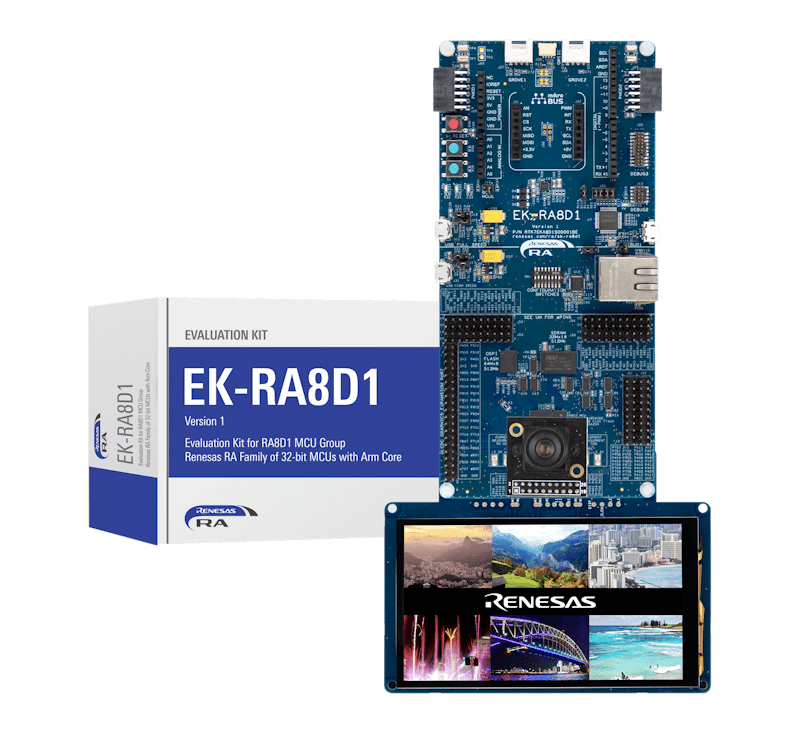Overview
Description
The EK-RA8D1 evaluation kit enables users to effortlessly evaluate the features of the RA8D1 MCU Group and develop embedded systems applications using Renesas' Flexible Software Package (FSP) and e2 studio IDE. Utilize rich onboard features along with your choice of popular ecosystem add-ons to bring your big ideas to life.
The EK-RA8D1 kit consists of three boards: the EK-RA8D1 board featuring the RA8D1 MCU with on-chip graphics LCD controller, a MIPI graphics expansion board featuring a 4.5-inch TFT color LCD (480 x 854) with capacitive touch overlay, and a camera expansion board featuring a 3M pixels CMOS image sensor.
Getting Started
Running the Quick Start Example Project
- The EK-RA8D1 board comes pre-programmed with a Quick Start example project (source code provided in the EK-RA8D1 example project bundle).
- Connect the MIPI graphics and camera expansion boards to the MIPI graphics (J58) and camera (J59) expansion ports on the EK-RA8D1 board.
- Power up the EK-RA8D1 board through the USB debug port (J10) using the micro USB device cable connected to a 5V power source. The white power LED will light up.
- The Quick Start example project will begin to execute showing the graphic elements on the screen.
- Refer to the EK-RA8D1 – Quick Start Guide to explore additional functionality of the Quick Start example project.
Developing Embedded Applications
- Modifying the Quick Start example project – Refer to the EK-RA8D1 Quick Start Guide for instructions on importing, modifying, and building the Quick Start example project.
- Start with one of the many other example projects (provided in the EK-RA8D1 example project's bundle) – Choose from many example projects to learn about different peripherals of the RA8D1 MCU group. These example projects can serve as excellent starting points for you to develop your custom applications.
Building Custom Hardware
- Start by building a functional prototype - Utilize the EK-RA8D1 board with your choice of ecosystem add-ons.
- Build custom hardware – Develop custom hardware by referring to the design and manufacturing information provided in the EK-RA8D1v1 - Design Package.
Features
- Special Feature Access
- MIPI DSI and Parallel Graphics Expansion Ports
- Camera Expansion Port
- Ethernet
- USB High-Speed Host and Device
- 64MB SDRAM
- 64MB External Octo-SPI Flash
- MCU Native Pin Access
- R7FA8D1BHECBD MCU
- 480MHz, Arm® Cortex®-M85 core
- 2MB Code Flash, 1MB SRAM
- 224 pins, BGA package
- Native pin access
- MCU and USB current measurement
- DC/DC mode configuration
- Ecosystem and System Control Access
- USB Full Speed Host and Device
- Multiple 5V input sources
- USB (debug, Full-Speed, High-Speed)
- External power supply
- SEGGER J-Link™ onboard programmer and debugger
- Debug modes
- Debug Onboard (SWD) – via J-Link
- Debug Out (SWD) – via J-Link
- Debug In (ETM, SWD and JTAG) – via J-Link, Arm® Keil® ULINK™, IAR I-jet™, Renesas E2/E2 Lite, etc.
- User LEDs and buttons
- Three user LEDs (red, blue, green)
- Power LED (white) indicating the availability of regulated power
- Debug LED (yellow) indicating the debug connection
- Two user buttons
- One reset button
- Five most popular ecosystem expansions
- MikroElektronika™ mikroBUS connector
- SparkFun® Qwiic® connectors (may not be populated)
- Two SeeedGrove® system (I2C and analog) connectors (may not be populated)
- Two Digilent Pmod™ (SPI and UART) connectors
- Arduino™ (Uno R3) connector
- MCU boot configuration
- MIPI Graphics Expansion Board
- 4.5 Inch backlit TFT display, 16.7M display colors
- 480x854 pixels resolution
- 2-lane MIPI interface
- Capacitive touch overlay (I2C)
- Camera Expansion Board
- Off-the-shelf Arducam CMOS OV3640 Camera Module
- ¼ Inch 3.1 Megapixel image sensor
- Up to 15 fps in QXGA (2048x1536 pixels) resolution
Applications
Design & Development
Support

Support Communities

Knowledge Base

Renesas Academy
Videos & Training
This demo highlights Renesas’ Smart Cooking Robot with the RA8D1 MCU, showcasing seamless embedded GUIs, real-time control, and interactive cooking features. Developers can quickly design, preview, and auto-generate professional-grade interfaces using Renesas FSP and e² studio, enabling faster appliance development and next-generation user experiences.
Related Resources
Additional Videos
News & Blog Posts
News
Dec 12, 2023
|
Blog Post
Dec 12, 2023
|
Blog Post
Jan 28, 2022
|
Blog Post
Jan 28, 2022
|
Blog Post
Nov 18, 2021
|
Blog Post
Nov 11, 2021
|
Certifications
The EK-RA8D1 kit meets the following certifications/standards. Refer to the EK-RA8D1 user manual for the disclaimer, precautions and more details on the certifications.
EMC/EMI Standards
- FCC Notice (Class A) – Part 15
- Innovation, Science and Economic Development Canada ICES-003 Compliance: CAN ICES-3 (A)/NMB-3(A)
- CE Class A (EMC Directive 2004/108/EEC)
- Taiwan Chinese National Standard 13438, C6357 compliance, Class A limits
- Australia/New Zealand AS/NZS CISPR 32:2015, Class A
Material Selection, Waste, Recycling, and Disposal Standards
- EU RoHS
- China SJ/T 113642014, 10-year environmental protection use period
Safety Standards
- UL 94V-0



